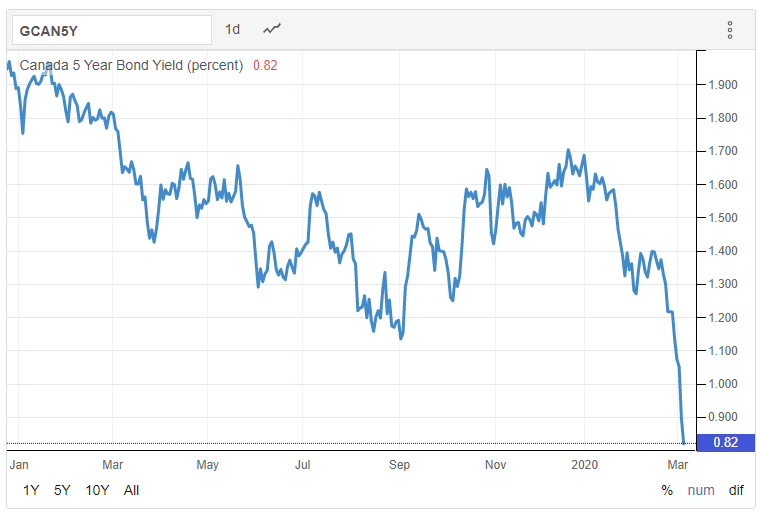Interest rates hit record lows. 5-year yield in Canada plunges to 0.82%.
Michael Hallett • March 4, 2020
The Bank of Canada Brings Out The Big Guns

Following yesterday's surprise emergency 50 basis point (bp) rate cut by the Fed, the Bank of Canada followed suit today and signalled it is poised to do more if necessary. The BoC lowered its target for the overnight rate by 50 bps to 1.25%, suggesting that "the COVID-19 virus is a material negative shock to the Canadian and global outlooks." This is the first time the Bank has eased monetary policy in four years.
According to the BoC's press release, "COVID-19 represents a significant health threat to people in a growing number of countries. In consequence, business activity in some regions has fallen sharply, and supply chains have been disrupted. This has pulled down commodity prices, and the Canadian dollar has depreciated. Global markets are reacting to the spread of the virus by repricing risk across a broad set of assets, making financial conditions less accommodative. It is likely that as the virus spreads, business and consumer confidence will deteriorate, further depressing activity." The press release went on to promise that "as the situation evolves, the Governing Council stands ready to adjust monetary policy further if required to support economic growth and keep inflation on target."
Moving the full 50 basis points is a powerful message from the Bank of Canada. Particularly given that Governor Poloz has long been bucking the tide of monetary easing by more than 30 central banks around the world, concerned about adding fuel to a red hot housing market, especially in Toronto. Other central banks will no doubt follow, although already-negative interest rates hamper the euro-area and Japan.
Canadian interest rates, which have been falling rapidly since mid-February, nosedived in response to the Bank's announcement. The 5-yield Government of Canada bond yield plunged to a mere 0.82% (see chart below), about half its level at the start of the year.
Fixed-rate mortgage rates have fallen as well, although not as much as government bond yields. The prime rate, which has been stuck at 3.95% since October 2018 when the Bank of Canada last changed (hiked) its overnight rate, is going to fall, but not by the full 50 bps as the cost of funds for banks has risen with the surge in credit spreads. A cut in the prime rate will lower variable-rate mortgage rates.
Many expect the Fed to cut rates again when it meets later this month at its regularly scheduled policy meeting, and the Canadian central bank is now expected to cut interest rates again in April. Of course, monetary easing does not address supply-chain disruptions or travel cancellations. Easing is meant to flood the system with liquidity and improve consumer and business confidence--just as happened in response to the financial crisis. Expect fiscal stimulus as well in the upcoming federal budget.
All of this will boost housing demand even though reduced travel from China might crimp sales in Vancouver. A potential recession is not good for housing, but lower interest rates certainly fuel what was already a hot spring sales market.
Data released today by the Toronto Real Estate Board show that Toronto home prices soared in February, and sales jumped despite low inventories. The number of transactions jumped 46% from February 2019, which was a 10-year sales low as the market struggled with tougher mortgage rules and higher interest rates. February sales were up by about 15% compared to January.
This article was written by DLC's chief economist Dr Sherry Cooper and was originally published on her client newsletter.
SHARE
MY INSTAGRAM
Mortgage Brokering meets mountain biking and craft beer. A couple months ago I set for a bike ride with the intention of answering few mortgage related questions, mission accomplished. Any good bike ride pairs nicely with a tasty beer which we enjoyed @parksidebrewery. Hope you see the passion I have for brokering, biking and beer. @torcabikes #mountainbikingmortgagebroker
TEASER alert...at thats what I think they call it in the business. Years ago a wrote a blog called BEERS BIKES AND MORTGAGES. I some how (in my head) blended all 3 topics into 1 blog. Simply put, I enjoy aspects of all 3 with each of them providing something different. I re-united with the talented Regan Payne on a project that I think will shed a bit more light on who I am and what I do. #craftbeer #mountainbike #mortgagebrokerbc #dlccanadainc
I saw this hat on Instagram, that very moment I knew I needed it. As a BC boy born and bred The Outdoorsman hat needed to be added to my collection. As someone who loves BC and most things outdoor, I’m now glad I have a cool hat to wear and fly the flag of BEAUTIFUL BRITISH COLUMBIA. It will be in my bag for all post-exploration celebratory cold pints. If you want to check them out or add one to your collection go to @nineoclockgun ...and yes my facial hair matches the hat as well.
View more

Bank of Canada maintains policy rate at 2.1/4%. FOR IMMEDIATE RELEASE Media Relations Ottawa, Ontario December 10, 2025 The Bank of Canada today held its target for the overnight rate at 2.25%, with the Bank Rate at 2.5% and the deposit rate at 2.20%. Major economies around the world continue to show resilience to US trade protectionism, but uncertainty is still high. In the United States, economic growth is being supported by strong consumption and a surge in AI investment. The US government shutdown caused volatility in quarterly growth and delayed the release of some key economic data. Tariffs are causing some upward pressure on US inflation. In the euro area, economic growth has been stronger than expected, with the services sector showing particular resilience. In China, soft domestic demand, including more weakness in the housing market, is weighing on growth. Global financial conditions, oil prices, and the Canadian dollar are all roughly unchanged since the Bank’s October Monetary Policy Report (MPR). Canada’s economy grew by a surprisingly strong 2.6% in the third quarter, even as final domestic demand was flat. The increase in GDP largely reflected volatility in trade. The Bank expects final domestic demand will grow in the fourth quarter, but with an anticipated decline in net exports, GDP will likely be weak. Growth is forecast to pick up in 2026, although uncertainty remains high and large swings in trade may continue to cause quarterly volatility. Canada’s labour market is showing some signs of improvement. Employment has shown solid gains in the past three months and the unemployment rate declined to 6.5% in November. Nevertheless, job markets in trade-sensitive sectors remain weak and economy-wide hiring intentions continue to be subdued. CPI inflation slowed to 2.2% in October, as gasoline prices fell and food prices rose more slowly. CPI inflation has been close to the 2% target for more than a year, while measures of core inflation remain in the range of 2½% to 3%. The Bank assesses that underlying inflation is still around 2½%. In the near term, CPI inflation is likely to be higher due to the effects of last year’s GST/HST holiday on the prices of some goods and services. Looking through this choppiness, the Bank expects ongoing economic slack to roughly offset cost pressures associated with the reconfiguration of trade, keeping CPI inflation close to the 2% target. If inflation and economic activity evolve broadly in line with the October projection, Governing Council sees the current policy rate at about the right level to keep inflation close to 2% while helping the economy through this period of structural adjustment. Uncertainty remains elevated. If the outlook changes, we are prepared to respond. The Bank is focused on ensuring that Canadians continue to have confidence in price stability through this period of global upheaval. Information note The next scheduled date for announcing the overnight rate target is January 28, 2026. The Bank’s next MPR will be released at the same time.

Following several challenging years, British Columbia’s housing market is beginning to stabilize. Prices, which experienced downward pressure in 2024–2025, have largely plateaued, with some areas showing modest gains. The recent Bank of Canada rate reduction to 2.25% has lowered borrowing costs, improving affordability and supporting market activity. Across the province, housing supply is gradually increasing. Builders are delivering more condos, townhomes, and single-family homes, easing some supply constraints. Meanwhile, population growth, fueled by domestic migration and international immigration, continues to support long-term housing demand. Key Statistics Home sales: BC home sales declined slightly in 2025 by approximately 1.1% to 73,650 units but are projected to rebound in 2026 by around 8.8%, reaching roughly 80,150 units. Average home price: The provincial average price dipped modestly by 0.9% in 2025 to $972,800, with forecasts projecting an increase of 3.2% in 2026 to approximately $1,004,000. Benchmark home price: As of April 2025, the BC benchmark home price stood at $953,500, down 1.3% year-over-year. Listings and inventory: Active listings are expected to exceed 40,000 units in 2025, the highest in more than a decade. Market Forecast 2025: Market remains relatively flat, with modest declines in sales and prices. 2026: Sales and prices begin to recover, with modest upward trends. Early 2027: Market stabilizes, reflecting measured growth and improved affordability. Regional differences will continue. Urban condo markets may see slower price appreciation, while suburban and smaller communities with limited supply could experience stronger gains. What This Means for Buyers and Homeowners Prospective buyers: 2026 is an opportunity to enter a more balanced market with lower interest rates. Current homeowners: Refinancing or mortgage renewal could be advantageous in this period of slightly lower rates. Investors: Localized analysis is critical, as neighborhood inventory and rental demand will determine returns. Bottom Line: BC’s housing market is shifting from a cooling phase toward a period of gradual recovery. Lower interest rates, steady population growth, and increased housing supply point to a healthier, more sustainable market. Buyers, homeowners, and investors should plan strategically, recognizing that while growth is returning, the pace will be measured and regionally variable.









































































































